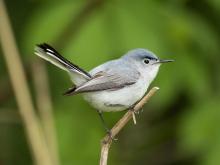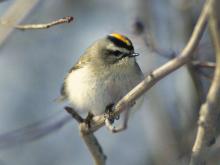Birds
Media

Species Types
Scientific Name
Piranga rubra
Description
Adult male summer tanagers are entirely red — an unforgettable sight as they forage for insects among bright green tree leaves in early summer.
Media

Species Types
Scientific Name
Stelgidopteryx serripennis
Description
Northern rough-winged swallows are sleek, agile fliers with brown upperparts, brownish-white throat, and whitish underparts. They are common summer residents in Missouri. People most often see them chasing flying insects over land or water.
Media

Species Types
Scientific Name
Ictinia mississippiensis
Description
The Mississippi kite is a rare summer resident in Missouri, usually seen flying above forests and grasslands along the Mississippi River valley. The flight of this rather small raptor is buoyant, like that of a swallow, or, yes, a kite.
Media

Species Types
Scientific Name
Polioptila caerulea
Description
Male blue-gray gnatcatchers are bluish gray and females are gray. The underparts are pale gray. The tail is black with white outer feathers, so when folded it appears white from below. There is a white eye ring. Common summer residents in Missouri, they habitually jerk their tails from side to side.
Media

Species Types
Scientific Name
Setophaga coronata (formerly Dendroica coronata)
Description
The yellow-rumped warbler is Missouri’s most abundant migrant warbler. It is also seen in winter. Adults have a yellow patch on the rump, the crown, and the sides near the bend of the wing.
Media

Species Types
Scientific Name
Corthylio calendula
Description
Kinglets are very small, active, insect-eating birds that Missourians see in winter and during migration in spring and fall. Ruby-crowned kinglets are grayish olive, have white wing bars, and flick their wings as they flit around. Males have a small red crown that they occasionally raise.
Media

Species Types
Scientific Name
Regulus satrapa
Description
Kinglets are very small, active, insect-eating birds that nervously flit around. Golden-crowned kinglets are grayish olive, with black and white striping on the sides of the head. The black cap has a yellow center. Males have a bright orange center to the yellow crown stripe.
Media

Species Types
Scientific Name
Cygnus olor
Description
The mute swan is a native of Eurasia that had been transplanted to America. It lives not only in parks and zoos but also, now, in natural habitats. In Missouri, it is seen in winter on rare occasions. Note its arched neck, orange bill, and black forehead knob.
Media

Species Types
Scientific Name
Falco peregrinus
Description
The fastest living animal, the peregrine falcon can dive at speeds of up to 261 miles per hour! It is being reintroduced to the state in urban areas, where skyscrapers replace the cliffs it traditionally nested on.
See Also







Media

Species Types
Scientific Name
Hemaris diffinis
Description
The snowberry clearwing is a moth that confuses people because it looks like a bumblebee and flies like a hummingbird!
Media

Species Types
Scientific Name
Hyles lineata
Description
The white-lined sphinx moth sometimes confuses people because it flies, hovers, and eats from flowers like a hummingbird. The adults often fly during daylight hours as well as in the night and are often found at lights.
Media

Species Types
Scientific Name
Darapsa myron
Description
The Virginia creeper sphinx moth is common in woods and brushy areas and comes to lights at night. The larvae eat Virginia creeper and grape leaves.
Media

Species Types
Scientific Name
Perimyotis subflavus (formerly Pipistrellus subflavus)
Description
Tri-colored bats, formerly called eastern pipistrelles, are relatively small and look pale yellowish or pale reddish brown. The main hairs are dark gray at the base, broadly banded with yellowish brown, and tipped with dark brown.
Media

Species Types
Scientific Name
Myotis grisescens
Description
Gray myotises are difficult to distinguish from other mouse-eared bats. A key identifying feature of the gray myotis is that its wing is attached to the ankle and not at the base of the toes. It’s an endangered species.
Media

Species Types
Scientific Name
Myotis lucifugus
Description
The little brown myotis (little brown bat) is one of our most common bats, but populations are declining. White-nose syndrome has taken a heavy toll in northeastern states. This species is now listed as vulnerable across its range.
Media

Species Types
Scientific Name
Myotis sodalis
Description
The Indiana myotis, or Indiana bat, summers along streams and rivers in north Missouri, raising its young under the bark of certain trees. It is an endangered species.
About Birds in Missouri
About 350 species of birds are likely to be seen in Missouri, though nearly 400 have been recorded within our borders. Most people know a bird when they see one — it has feathers, wings, and a bill. Birds are warm-blooded, and most species can fly. Many migrate hundreds or thousands of miles. Birds lay hard-shelled eggs (often in a nest), and the parents care for the young. Many communicate with songs and calls.





















